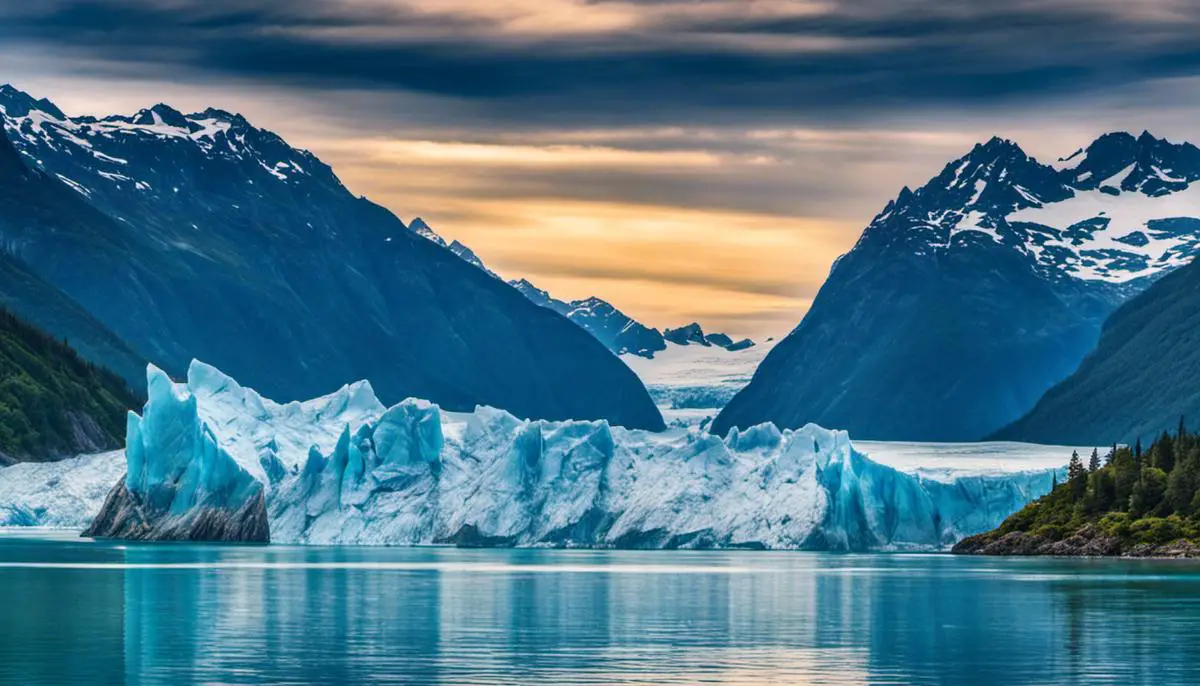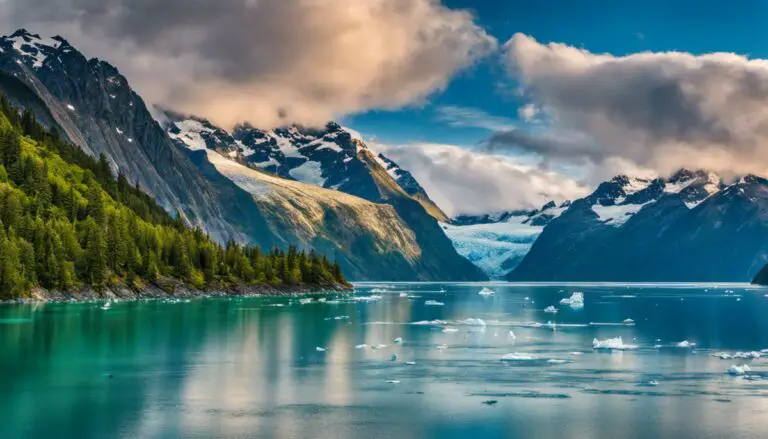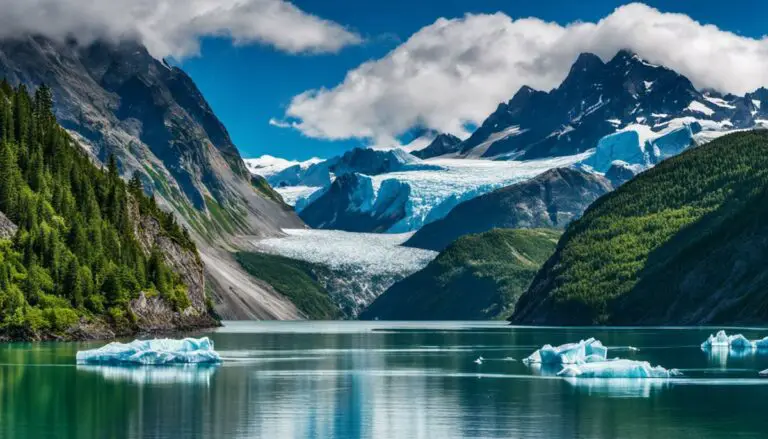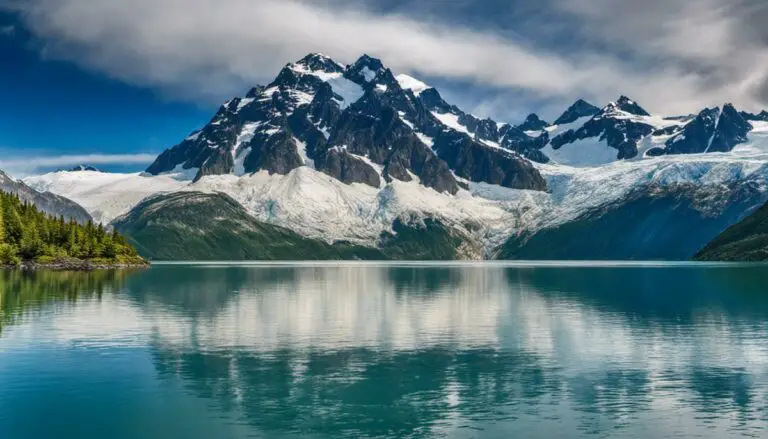Immerse yourself in the sublime natural wonders of Glacier Bay National Park and Preserve—an incredible world of ice, water, rock, and wildlife tucked away in the vastness of Alaska. Awash with a series of vivid landscapes, from ice-sculpted mountains to deep fjords together with an active tidewater glacier spectacular to behold, it stands as a testament to the unspoiled beauty of our earth. Combined with an intrinsically complex ecosystem, this park, which is a hub of flora, fauna, and all things serene, draws in universal appeal. Yet, it’s not just the natural allure; the park also carries a rich tapestry of human history and cultural significance stretching back thousands of years offering an enriching exploration opportunity.

The Stunning Natural Beauty of Glacier Bay
The Dynamic Landscape of Glacier Bay National Park and Preserve
A testament to the transformative power of nature, Glacier Bay National Park and Preserve in southeastern Alaska is a living tableau of ever-changing landscapes. It showcases a dynamic geological spectacle characterized by a stunning panorama of ice-sculpted peaks and deep fjords. Here, colossal glaciers have carved the mountains and valleys over thousands of years, creating a vibrant and ever-evolving ecosystem that continues to fascinate scientists and tourists alike.
One of the park’s highlight features is its active tidewater glaciers, particularly the Margerie and Johns Hopkins Glaciers. Unique to Glacier Bay, these towering masses of ice extend from the mountains to the sea, periodically calving – a spectacular natural event where chunks of ice split off and crash into the bay with thunderous roars.
Flora and Fauna in a Unique Ecosystem
Equally captivating is the park’s abundant flora and fauna, essential components of its complex ecosystem. Plant life in Glacier Bay is rich and varied, teetering between resilience and fragility as the landscape shifts under the influence of glacial movement. Areas recently exposed by retreating ice serve as a canvas for nature’s grand experiment in succession, where pioneering species such as fireweed, willow, and alder are gradually replaced by Sitka spruce and western hemlock forests over hundreds of years.
Glacier Bay’s fauna, on the other hand, is a diverse collection of species finely tuned to the challenges of this extreme environment. Visitors to the park can spot coastal brown bears, mountain goats, and moose, as well as marine mammals like humpback whales, sea otters, and harbor seals. More than 280 species of birds, including the rare Kittlitz’s murrelet, also call this park home.
Despite the extreme conditions inherent in its environment, Glacier Bay National Park is teeming with life. Each dramatic shift in the glacier’s progression carries with it an opportunity for a new ecological era, giving life to an area once covered in ice. The park’s isolation and harsh conditions allow for a virtually untouched wilderness, providing a unique living laboratory for studying plant and animal adaptation and evolution.
The Attractions of Glacier Bay National Park and Preserve
Glacier Bay National Park and Preserve boasts pristine waterways, dramatic landscapes, and a generous display of wildlife, each contributing to its overwhelming tourist appeal. With its unique and ever-changing weather patterns, the park records around half a million visitors annually. Tourists engage in diverse activities such as kayaking, camping, and glacier tours, while others savor the opportunity to experience the vibrant natural processes unfolding. The park also offers a glimpse into the rich cultural heritage of the Huna Tlingit people, demonstrated through its preserved archaeological sites.
For the sake of preserving its original allure and reducing any negative human impact, special regulations have been established, such as frequent closures around tidewater glaciers allowing seals to safely raise their pups. Through sustainable practices, Glacier Bay National Park and Preserve highlights how human enjoyment and understanding of these unique environments can still coincide with their enduring conservation.

The Human History and Cultural Significance of Glacier Bay
The Tlingit People: Glacier Bay’s Earliest Occupants
Glacier Bay’s rich history can be traced back thousands of years to its earliest known inhabitants, the indigenous Tlingit people. For over 10,000 years, Tlingit tribes have made this region their home, thriving on a lifestyle primarily reliant on the sea’s bounty of hunting, fishing, and gathering opportunities. The Tlingit refer to Glacier Bay as “Sit’ Eeti Gheeyi,” or “the bay in place of the glacier,” reflective of the essential role the area has played in their culture and lifestyle.
Discovery by European Explorers
The initial sighting by European explorers was by George Vancouver in 1794. During his exploration, he noted a monumental wall of ice that was more than 20 miles in width and about 4,000 feet thick. He couldn’t go further into the bay due to the impenetrable ice. When explorers returned to the bay in 1879, led by naturalist John Muir, they were surprised to find that the glacier had retreated more than 30 miles up the bay, revealing new lands and deeper waters.
Scientific Research and Tourism Impact
In recent years, Glacier Bay has served as a significant field study location for scientists and researchers studying glaciology, marine ecosystems, and the impacts of climate change on these environments. The retreat of the glaciers has led to an influx of marine wildlife, making it a popular destination for tourists and wildlife enthusiasts. However, the increasing visitor populations pose their own challenges for managing environmental impacts.
Preservation Efforts and UNESCO World Heritage Status
Recognizing Glacier Bay’s ecological significance and natural beauty, the U.S. Congress designated it as a National Monument in 1925 and later as a National Park and Preserve in 1980. This measure was taken to protect its unique features and rich diversity of flora and fauna.
In 1979, Glacier Bay National Park, along with Wrangell-St. Elias National Park, Kluane National Park in Canada, and Tatshenshini-Alsek Park in British Columbia, were declared a combined World Heritage Site by UNESCO, recognized for their globally significant glacial processes and large intact ecosystems, such as the grizzly bear, wolf, moose, and Dall’s sheep populations.
The Cultural Importance of Glacier Bay
The cultural and historical significance of Glacier Bay is as vast as its natural splendor. The Tlingit people, who view the bay as their ancestral home, imbue the area with profound cultural importance. Today, Glacier Bay remains a vibrant cultural landscape, with local indigenous communities continuing to nurture their strong bonds with the land.
Various initiatives to revitalize and interpret the history and culture of the Tlingit people in Glacier Bay are in progress. Through park programs such as Tlingit tribal house tours, ranger-led activities, and tribal demonstrations, visitors can delve into the wealth of the area’s cultural heritage. The goal of these interpretive activities is to illuminate the historical events, the intrinsic link of the native clan with the environment, and the essence of Tlingit culture for visitors.

Things to Do in Glacier Bay National Park and Preserve
Exploring the Splendors of Glacier Bay National Park
Glacier Bay National Park and Preserve in Alaska offers tourists and nature enthusiasts rich, diverse experiences in its sprawling 3.3 million acres. This breathtaking sanctuary, which has been designated a UNESCO World Heritage site, hosts a wealth of ecosystems, imposing glaciers, and a wealth of wildlife. It’s not just a haven for adventure and sightseeing; it’s also a platform for learning about unique geological phenomena amidst captivating landscapes.
Hiking and Camping
Among the vast wilderness of this national park, hiking trails of various difficulties offer the chance to observe towering mountain peaks, expansive glaciers, tranquil water bodies, and rich flora and fauna. The Bartlett River Trail, Beardslee Entrance Trail, and Bartlett Lake Trail are some of the popular tracks, each offering unique perspectives of the park’s landscape. There are no designated campgrounds within the park, but overnight camping is allowed with a free permit which can be obtained at the park’s visitor center.
Kayaking and Boating
Kayaking or boating through the Glacier Bay waters provides a unique perspective of the park’s wonders, including the magnificent tidewater glaciers. Kayak rentals are available at Bartlett Cove and boating offers additional opportunities to view the park’s marine wildlife, such as seals, whales, and sea otters.
Wildlife Viewing
The park is home to a myriad of wildlife species including brown bears, moose, mountain goats, humpback and orca whales, sea otters, seals, and over 200 species of birds, making it a paradise for wildlife enthusiasts. Spot the elusive coastal wolves and wolverines or go bird watching for eagles, puffins, and the rare marbled murrelets.
Visitor Services and Facilities
The park’s visitor services offer a range of amenities designed to optimize the visitor experience. The Glacier Bay Lodge is available for accommodation, featuring cozy rooms with rustic decor, and a full-service restaurant. The Bartlett Cove Campground offers primitive camping facilities. Additionally, the visitor center provides various interpretive programs and exhibits about the park’s natural and cultural history.
Weather Conditions and Safety Tips
The weather in Glacier Bay is unpredictable and changes rapidly. Visitors are recommended to dress in layers and bring waterproof clothing, even during the summer months. In the wilderness area, it’s important to maintain a safe distance from wildlife and to store food properly in order to prevent attracting bears. Visitors planning backcountry hikes or camping should make themselves aware of bear safety procedures.
Planning Your Visit
A visit to Glacier Bay National Park and Preserve is best planned during the months of June through August, when the weather is milder, and most of the park’s services and facilities are operational. It’s ideal to book accommodations well in advance, as Glacier Bay Lodge and other local lodgings can fill up quickly. While there are no entrance fees for the park, some activities may require permits. Always check park regulations and guidelines for the most up-to-date information on closures, restrictions, and safety information.
In conclusion
Glacier Bay National Park and Preserve stands as an incredible testament to nature’s raw power and magnificence, offering an unmatched experience for outdoor enthusiasts looking to delve into Alaska’s wilderness.

With its awe-inspiring wilderness, exciting range of activities and notable historical and cultural significance, Glacier Bay National Park and Preserve truly stands as a treasure of natural and human history. It presents an incredible journey for both the casual observer and the adventurous explorer that’s brimming with invaluable experiences. Whether it’s peering up at towering glaciers, observing its rich ecosystem, deciphering the chapters of its past, or planning your unique adventure amidst its grandeur, this park is certain to leave you with lasting impressions. So, now that you’re equipped with the essential knowledge about this haven, let this be your call to explore, admire, and preserve the magnificent spectacle that is the Glacier Bay National Park and Preserve.
Proud owner of https://travelyouman.com/
